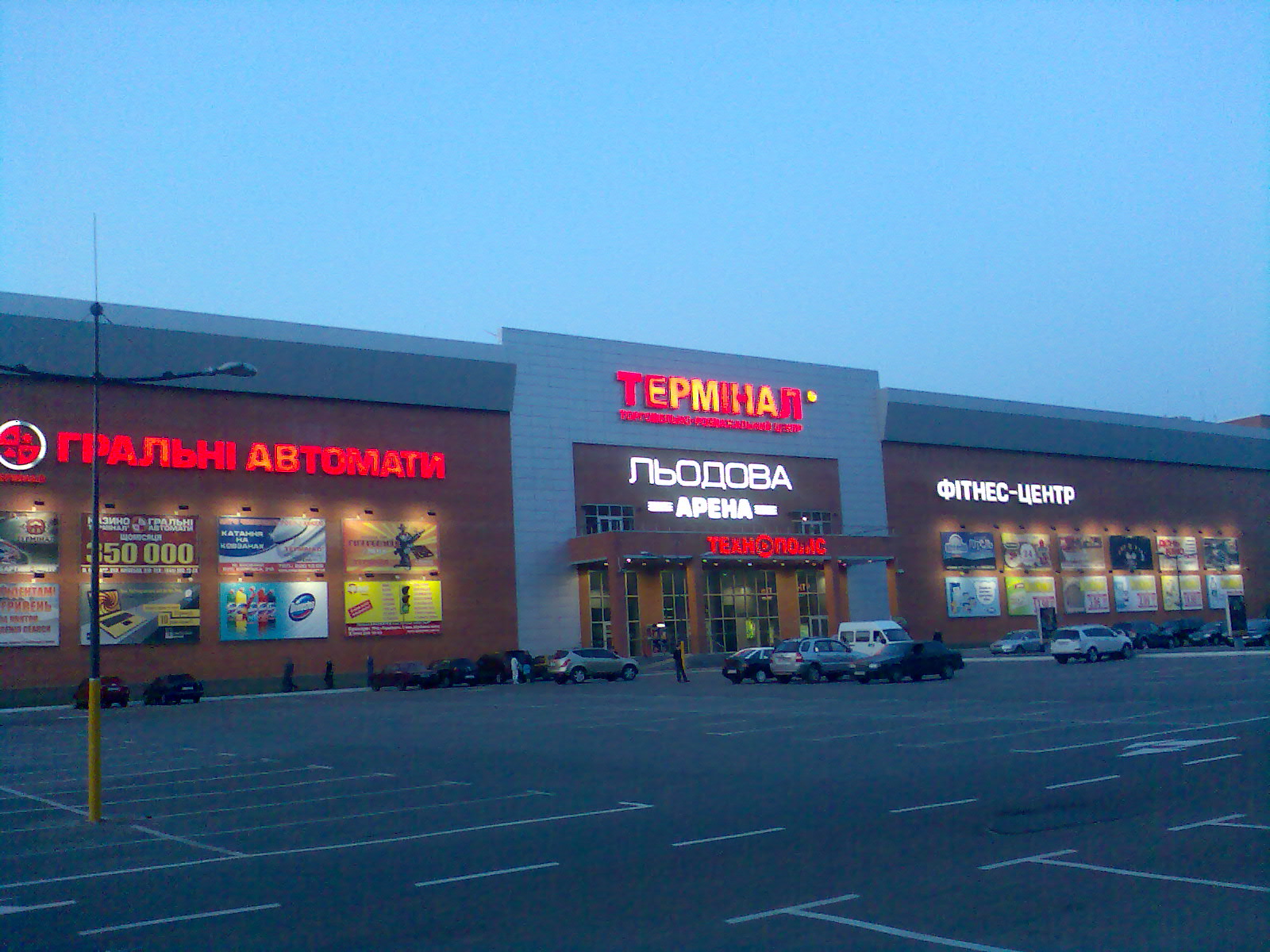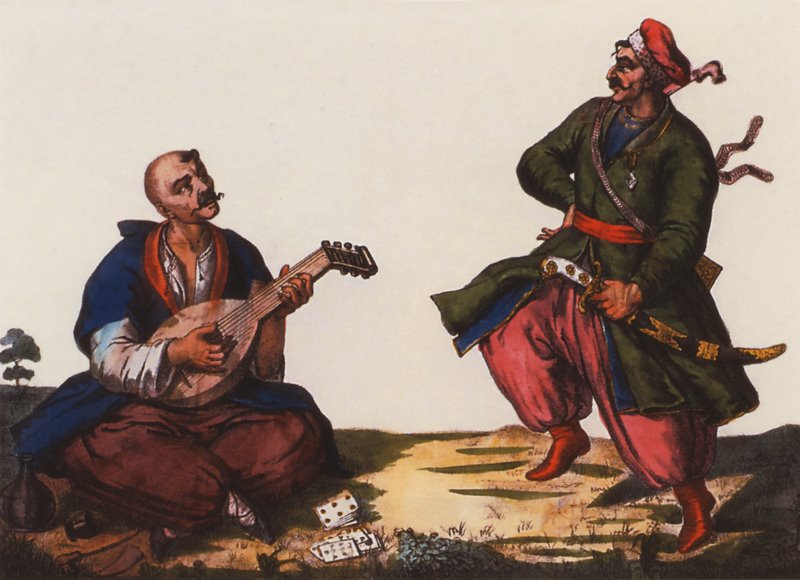|
Kobzar Guilds
Kobzar guilds, regional organizations of kobzars and lirnyks, were widespread in the mid-19th century. Modeled on artisans' guilds, they protected their members' interests. Every brotherhood had its own secret traditions and regulations. Its members collectively chose as their centre a church, for which they bought icons, candles, and oil. They met at the church on certain holy days to attend requiem services for deceased members and to settle urgent matters. In the spring they secretly gathered elsewhere (usually the forests near Brovary outside Kyiv) to elect their officers, to define the territory on which individual kobzars could operate, and to initiate new members according to a prescribed ritual. If necessary, the elected leader (pan otets) would call additional meetings. To become a member one had to have a physical handicap, to study kobza playing with a master (usually for at least two years), and to obtain permission ( vyzvilka) to perform independently, to know the kobzars ... [...More Info...] [...Related Items...] OR: [Wikipedia] [Google] [Baidu] |
Kobzar
A ''kobzar'' ( ua, кобзар, pl. kobzari ua, кобзарі) was an itinerant Ukrainian bard who sang to his own accompaniment, played on a multistringed bandura or kobza. Tradition Kobzars were often blind and became predominantly so by the 1800s. ''Kobzar'' literally means ' kobza player', a Ukrainian stringed instrument of the lute family, and more broadly — a performer of the musical material associated with the kobzar tradition. The professional kobzar tradition was established during the Hetmanate Era around the sixteenth century in Ukraine. Kobzars accompanied their singing with a musical instrument known as the kobza, bandura, or lira. Their repertoire primarily consisted of para-liturgical psalms and "kanty", and also included a unique epic form known as dumas. At the turn of the nineteenth century there were three regional kobzar schools: Chernihiv, Poltava, and Slobozhan, which were differentiated by repertoire and playing style. Guilds In Ukraine, ... [...More Info...] [...Related Items...] OR: [Wikipedia] [Google] [Baidu] |
Lirnyk
] The lirnyk ( Ukrainian language, Ukrainian: лірник; plural лірники - lirnyky) were itinerant Ukrainian musicians who performed religious, historical and epic songs to the accompaniment of a lira, the Ukrainian version of the hurdy-gurdy. Lirnyky were similar to and belonged to the same guilds as the better known bandura players known as kobzars. However, the lirnyk played the lira, a kind of crank-driven hurdy-gurdy, while the kobzars played the lute-like banduras. Lirnyky were usually blind or had some major disability. They were active in all areas of Ukraine from (at least) the 17th century on. The tradition was discontinued in Eastern/Central Ukraine in the mid-1930s, some lirnyky were seen in the regions of Western Ukraine until the 1970s and even the 1980s. Today, the repertoire of the instrument is mostly performed by educated, sighted performers. Notable performers of the lira include Mykhailo Khai, Vadym "Yarema" Shevchuk, Volodymyr Kushpet and Andr ... [...More Info...] [...Related Items...] OR: [Wikipedia] [Google] [Baidu] |
Brovary
Brovary ( uk, Бровари, , yi, בראָוואַר, Brovar) is a city in Kyiv Oblast (Region) in northern Ukraine, an eastern suburb of the country's capital, Kyiv. It is the administrative centre of Brovary Raion (district). Brovary hosts the administration of Brovary urban hromada, one of the hromadas of Ukraine. Its population is approximately History Brovary is a historic town, first mentioned in 1630. Its name, translated from Ukrainian, means 'breweries' (and is a loanword from Dutch). The city also houses a railway station. International ill-fame came to the city in 2000 after one of its apartment blocks was hit by a stray surface-to-surface missile launched from a neighbouring army shooting range in Honcharivs'ke. Three people were killed. In the 21st century, Brovary is Ukraine's shoe-making capital, with dozens of such companies located there. There is also a broadcasting centre for long and shortwave transmissions. The longwave transmitter, which works ... [...More Info...] [...Related Items...] OR: [Wikipedia] [Google] [Baidu] |
Kyiv
Kyiv, also spelled Kiev, is the capital and most populous city of Ukraine. It is in north-central Ukraine along the Dnieper, Dnieper River. As of 1 January 2021, its population was 2,962,180, making Kyiv the List of European cities by population within city limits, seventh-most populous city in Europe. Kyiv is an important industrial, scientific, educational, and cultural center in Eastern Europe. It is home to many High tech, high-tech industries, higher education institutions, and historical landmarks. The city has an extensive system of Transport in Kyiv, public transport and infrastructure, including the Kyiv Metro. The city's name is said to derive from the name of Kyi, one of its four legendary founders. During History of Kyiv, its history, Kyiv, one of the oldest cities in Eastern Europe, passed through several stages of prominence and obscurity. The city probably existed as a commercial center as early as the 5th century. A Slavs, Slavic settlement on the great trade ... [...More Info...] [...Related Items...] OR: [Wikipedia] [Google] [Baidu] |
Kobza
The kobza ( uk , кобза), also called bandurka ( uk , бандурка) is a Ukrainian folk music instrument of the lute family ( Hornbostel-Sachs classification number 321.321-5+6), a relative of the Central European mandora. The term ''kobza'' however, has also been applied to a number of other Eastern European instruments distinct from the Ukrainian kobza. Construction The Ukrainian kobza was a traditionally gut-strung, lute-like stringed musical instrument with a body hewn from a single block of wood. Instruments with a staved assembly also exist. The kobza has a medium-length neck which may or may not have tied-on frets, which were usually made of gut. It was single-strung (sometimes also double-strung) and the strings were played with fingertips or occasionally with a plectrum threaded through a ring placed on the middle finger. History The term kobza is of Turkic origin and is related to the terms kobyz and komuz, thought to have been introduced into the Ukrainian l ... [...More Info...] [...Related Items...] OR: [Wikipedia] [Google] [Baidu] |
Lirnyk
] The lirnyk ( Ukrainian language, Ukrainian: лірник; plural лірники - lirnyky) were itinerant Ukrainian musicians who performed religious, historical and epic songs to the accompaniment of a lira, the Ukrainian version of the hurdy-gurdy. Lirnyky were similar to and belonged to the same guilds as the better known bandura players known as kobzars. However, the lirnyk played the lira, a kind of crank-driven hurdy-gurdy, while the kobzars played the lute-like banduras. Lirnyky were usually blind or had some major disability. They were active in all areas of Ukraine from (at least) the 17th century on. The tradition was discontinued in Eastern/Central Ukraine in the mid-1930s, some lirnyky were seen in the regions of Western Ukraine until the 1970s and even the 1980s. Today, the repertoire of the instrument is mostly performed by educated, sighted performers. Notable performers of the lira include Mykhailo Khai, Vadym "Yarema" Shevchuk, Volodymyr Kushpet and Andr ... [...More Info...] [...Related Items...] OR: [Wikipedia] [Google] [Baidu] |
Bandurist
A banduryst ( uk, бандури́ст) is a person who plays the Ukrainian plucked string instrument known as the bandura. Types of performers There are a number of different types of bandurist who differ in their particular choice of instrument, the specific repertoire they play and manner in which they approach their vocation. * Kobzari, who play authentic ethnographic instruments or copies. This group can also be further categorized into ''authentic'', ''reproduction'', and ''stage'' performers. *Academic players, playing more sophisticated contemporary concert banduras. These performers have a tertiary education majoring in bandura performance and typically perform works by Western classical composers in addition to, or instead of, Ukrainian folk music. This category can be further divided into instrumentalists (who only perform instrumental works) and vocalists (who primarily use the bandura to accompany their voice). The most common academic bandurists play in the Kiev ... [...More Info...] [...Related Items...] OR: [Wikipedia] [Google] [Baidu] |
Kobzar
A ''kobzar'' ( ua, кобзар, pl. kobzari ua, кобзарі) was an itinerant Ukrainian bard who sang to his own accompaniment, played on a multistringed bandura or kobza. Tradition Kobzars were often blind and became predominantly so by the 1800s. ''Kobzar'' literally means ' kobza player', a Ukrainian stringed instrument of the lute family, and more broadly — a performer of the musical material associated with the kobzar tradition. The professional kobzar tradition was established during the Hetmanate Era around the sixteenth century in Ukraine. Kobzars accompanied their singing with a musical instrument known as the kobza, bandura, or lira. Their repertoire primarily consisted of para-liturgical psalms and "kanty", and also included a unique epic form known as dumas. At the turn of the nineteenth century there were three regional kobzar schools: Chernihiv, Poltava, and Slobozhan, which were differentiated by repertoire and playing style. Guilds In Ukraine, ... [...More Info...] [...Related Items...] OR: [Wikipedia] [Google] [Baidu] |
Blind Musicians
Blind musicians are singers or instrumentalists, or in some cases singer-accompanists, who are legally blind. Resources Historically, many blind musicians, including some of the most famous, have performed without the benefit of formal instruction, since such instruction relies extensively on written musical notation. However, today there are many resources available for blind musicians who wish to learn Western music theory and classical notation. Louis Braille, the man who created the braille alphabet for the blind, also created a system of classical notation for the blind called Braille music. This system allows the blind to read and write music much as the sighted do. The largest collection of Braille musical scores is located at the Library of Congress in Washington, D.C. Outside the U.S., the largest collection of braille music scores is stored at the National Library for the Blind in England. Computer technology and the Internet make it possible in theory for blind ... [...More Info...] [...Related Items...] OR: [Wikipedia] [Google] [Baidu] |
Ukrainian Music
Ukrainian music covers diverse and multiple component elements of the music that is found in the Western and Eastern musical civilization. It also has a very strong indigenous Slavic and Christian uniqueness whose elements were used among the areas that surround modern Ukraine. Ukraine is also the rarely acknowledged musical heartland of the former Russian Empire, home to its first professional music academy, which opened in the mid-18th century and produced numerous early musicians and composers. Modern Ukraine is situated north of the Black Sea, previously part of the Soviet Union. Several of its ethnic groups living within Ukraine have their own unique musical traditions and some have developed specific musical traditions in association with the land in which they live. Folk music Ukraine found itself at the crossroads of Asia and Europe and this is reflected within the music in a perplexing mix of exotic melismatic singing with chordal harmony which does not always eas ... [...More Info...] [...Related Items...] OR: [Wikipedia] [Google] [Baidu] |



.jpg)


